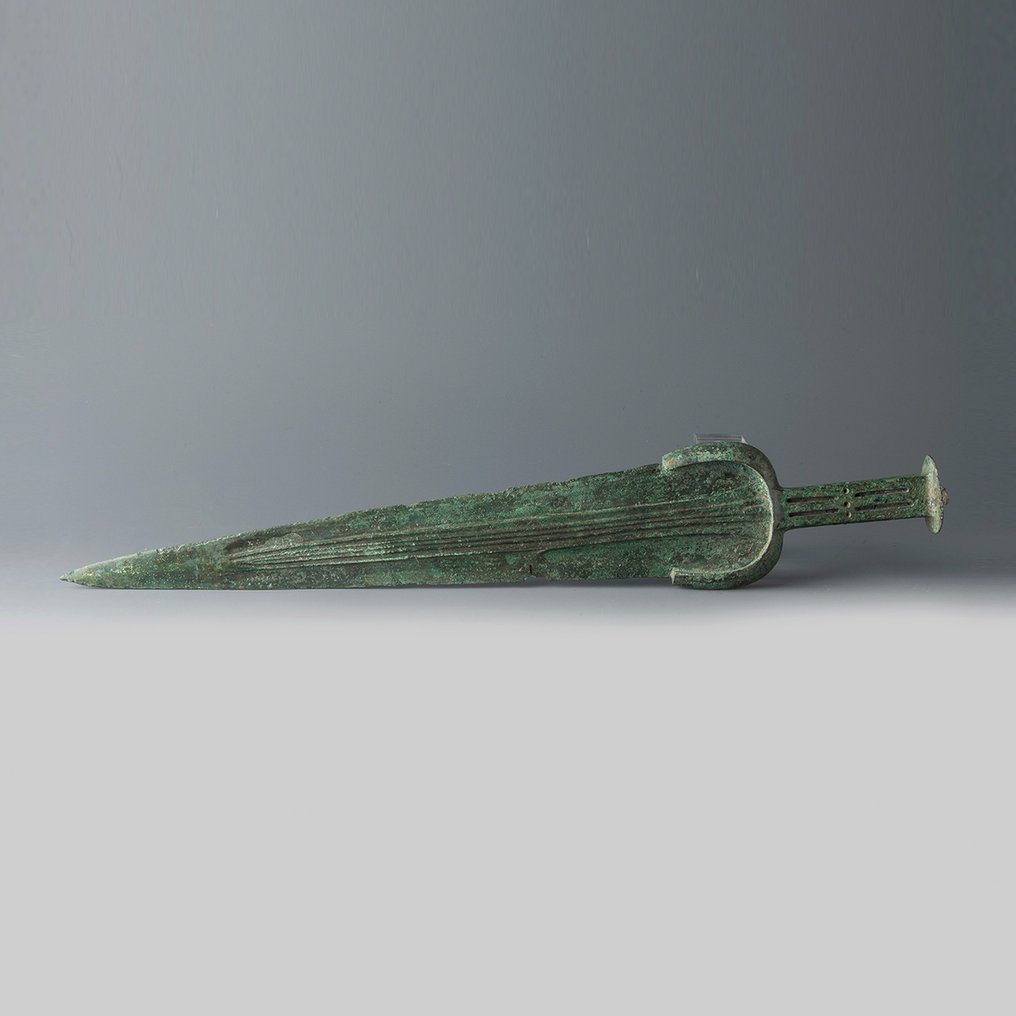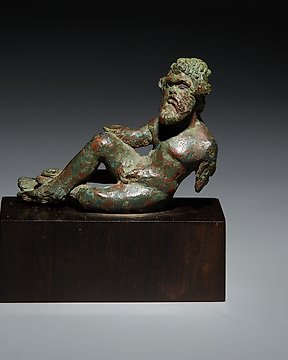
Uralt Bronze Ägyptische sitzende Bronzefigur des Amun, König der Götter, H. 17,6 cm, Saitenzeit, ca. 664-525 v. - 17.6 cm
Catawiki nutzt immer die neuesten Technologien. Sie verwenden derzeit einen veralteten Browser. Aktualisieren Sie bitte Ihren Browser, damit Sie immer alle neuen Funktionen optimal nutzen können.
Über die folgenden Buttons können Sie Ihre Cookie-Einstellungen auswählen. Sie können Ihre bevorzugten Einstellungen ändern und Ihre Zustimmung jederzeit widerrufen. Eine detaillierte Beschreibung aller Arten von Cookies, die wir und unsere Partner verwenden, finden Sie in unserer Cookie-Erklärung.
Nr. 84074883



SWORD
Luristan, 8th century BC
Bronze
Length 52 cm and width 9 cm
Provenance
- Private collection, Mézières-lez-Cléry, France. Acquired by inheritance in 2022.
Condition
Good condition, intact.
Sword made of bronze by casting in a single piece that includes the blade, guard and fist. Double-edged, cutting and stabbing, the symmetrical triangular blade is wider at its junction with the guard, ends in a sharp point and is decorated with a striated band worked in relief, which replaces the nerve and extends from the guard, narrowing , ending before reaching the tip, about a quarter of the length of the blade.
The decoration is the same on both sides, and although schematic it shows the taste for the play of curves and straight lines typical of the Luristan bronzes, given that the lines of this central band open smoothly at its junction with the guard. It is also a complex design, which combines two thicker individual edges on the sides and a group of three thinner ones in the central area. These three remain straight throughout their entire length, with only the lateral edges that curve and open at the top of the blade. A sword with a very similar decoration is preserved in the Louvre Museum, which also plays with different types of edges in the central area of the blade and has the same guard (fig. 1).
The guard follows an elegant shape, with an arched design that closes slightly downwards. Directly from its upper profile, without cuts, emerges the hilt of the sword, with a rectangular section and ending in a flat circular pommel, crowned in turn by a small projection. The body of the fist is decorated with grooves and circles excavated on its four sides, which originally could have been colored with some type of embedded material, such as vitreous paste or bone.
The Luristan culture developed between the 11th and 8th centuries BC, when it was eliminated by conflicts in the area during that century. They were a nomadic people from the south of Russia, settled in the Iranian plateau and composed of different independent groups, without national identity but with common cultural characteristics. This town developed a rich metal culture, working mainly with bronze. With it they made all kinds of functional pieces and weapons, as well as votive offerings and objects of personal adornment. His was a figurative art, although cryptic and deeply symbolic, that sought expressiveness over naturalism. In the Luristan pieces, a marked axis of symmetry is always appreciated, as can be seen in this sword, with brief ornamentation but nevertheless endowed with fluid shapes that refer to the plant world. Through this simple design, the organic is suggested, giving the piece the appearance of a leaf without actually making it concrete, playing with suggestion and formal evocation. In fact, the ambiguity of forms and motifs was a constant in the pieces of this culture, mainly in the figures of divinities, although it was a concept, as seen here, completely assimilated and extended to all production.
Bibliography
- MOOREY, P.R.S. Ancient Bronzes from Luristan. British Museum. 1974.
- MUSCARELLA, O.W. “Bronzes of Luristan”. Encyclopaedia Iranica, vol. III. Encyclopaedia Iranica Foundation. 1989.
Parallels
Fig. 1 Sword. Luristan, Iran, s. XI-VIII BC Bronze. Musée du Louvre, Paris, inv. AO 21109.
Notes:
- The piece includes authenticity certificate.
- The piece includes Spanish Export License.
- The seller guarantees that he acquired this piece according to all national and international laws related to the ownership of cultural property. Provenance statement seen by Catawiki.
SWORD
Luristan, 8th century BC
Bronze
Length 52 cm and width 9 cm
Provenance
- Private collection, Mézières-lez-Cléry, France. Acquired by inheritance in 2022.
Condition
Good condition, intact.
Sword made of bronze by casting in a single piece that includes the blade, guard and fist. Double-edged, cutting and stabbing, the symmetrical triangular blade is wider at its junction with the guard, ends in a sharp point and is decorated with a striated band worked in relief, which replaces the nerve and extends from the guard, narrowing , ending before reaching the tip, about a quarter of the length of the blade.
The decoration is the same on both sides, and although schematic it shows the taste for the play of curves and straight lines typical of the Luristan bronzes, given that the lines of this central band open smoothly at its junction with the guard. It is also a complex design, which combines two thicker individual edges on the sides and a group of three thinner ones in the central area. These three remain straight throughout their entire length, with only the lateral edges that curve and open at the top of the blade. A sword with a very similar decoration is preserved in the Louvre Museum, which also plays with different types of edges in the central area of the blade and has the same guard (fig. 1).
The guard follows an elegant shape, with an arched design that closes slightly downwards. Directly from its upper profile, without cuts, emerges the hilt of the sword, with a rectangular section and ending in a flat circular pommel, crowned in turn by a small projection. The body of the fist is decorated with grooves and circles excavated on its four sides, which originally could have been colored with some type of embedded material, such as vitreous paste or bone.
The Luristan culture developed between the 11th and 8th centuries BC, when it was eliminated by conflicts in the area during that century. They were a nomadic people from the south of Russia, settled in the Iranian plateau and composed of different independent groups, without national identity but with common cultural characteristics. This town developed a rich metal culture, working mainly with bronze. With it they made all kinds of functional pieces and weapons, as well as votive offerings and objects of personal adornment. His was a figurative art, although cryptic and deeply symbolic, that sought expressiveness over naturalism. In the Luristan pieces, a marked axis of symmetry is always appreciated, as can be seen in this sword, with brief ornamentation but nevertheless endowed with fluid shapes that refer to the plant world. Through this simple design, the organic is suggested, giving the piece the appearance of a leaf without actually making it concrete, playing with suggestion and formal evocation. In fact, the ambiguity of forms and motifs was a constant in the pieces of this culture, mainly in the figures of divinities, although it was a concept, as seen here, completely assimilated and extended to all production.
Bibliography
- MOOREY, P.R.S. Ancient Bronzes from Luristan. British Museum. 1974.
- MUSCARELLA, O.W. “Bronzes of Luristan”. Encyclopaedia Iranica, vol. III. Encyclopaedia Iranica Foundation. 1989.
Parallels
Fig. 1 Sword. Luristan, Iran, s. XI-VIII BC Bronze. Musée du Louvre, Paris, inv. AO 21109.
Notes:
- The piece includes authenticity certificate.
- The piece includes Spanish Export License.
- The seller guarantees that he acquired this piece according to all national and international laws related to the ownership of cultural property. Provenance statement seen by Catawiki.








